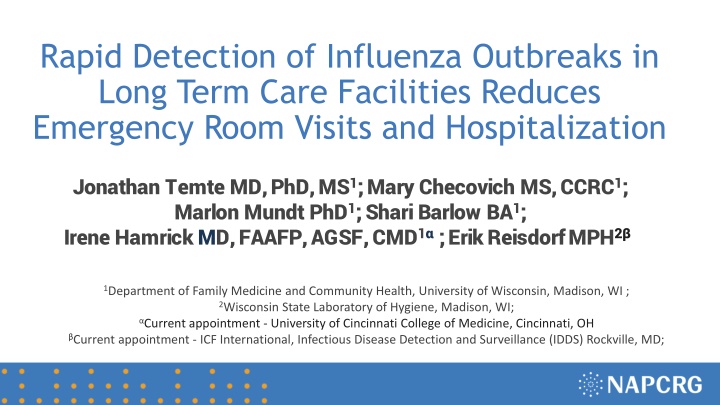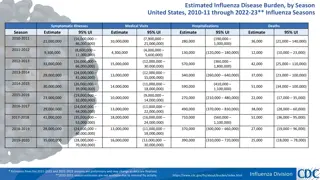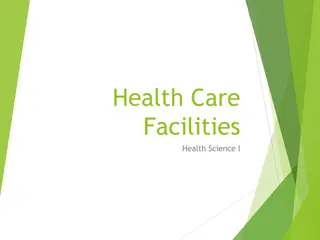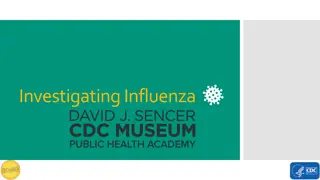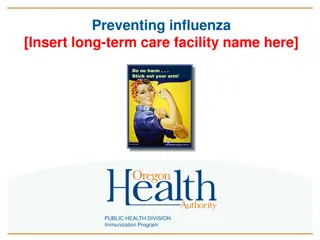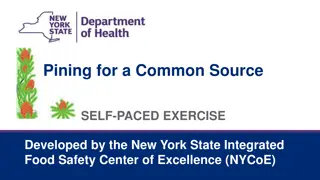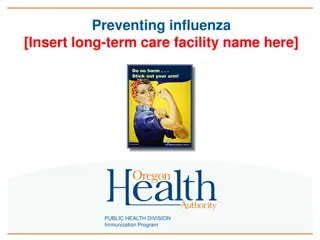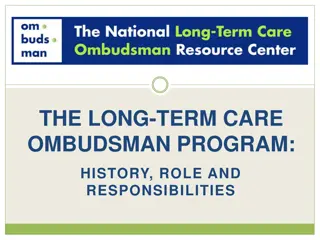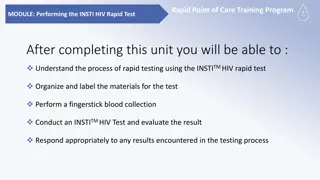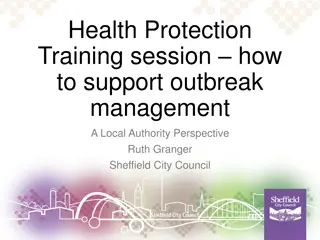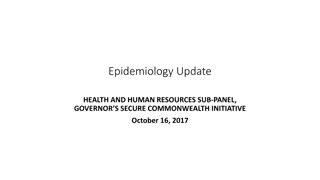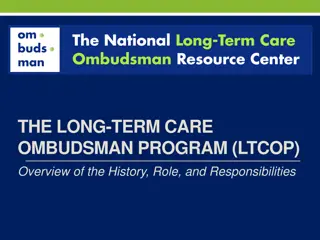Rapid Influenza Outbreak Detection in Long-Term Care Facilities
The research investigates the effectiveness of rapid diagnostics in detecting influenza outbreaks in long-term care facilities. A non-blinded, randomized controlled trial in Wisconsin LTCFs showed that the intervention led to higher oseltamivir prophylaxis use, decreased ED visits, hospitalizations, and shorter hospital stays. However, no significant differences were noted in respiratory-related outcomes or mortality rates.
Download Presentation

Please find below an Image/Link to download the presentation.
The content on the website is provided AS IS for your information and personal use only. It may not be sold, licensed, or shared on other websites without obtaining consent from the author.If you encounter any issues during the download, it is possible that the publisher has removed the file from their server.
You are allowed to download the files provided on this website for personal or commercial use, subject to the condition that they are used lawfully. All files are the property of their respective owners.
The content on the website is provided AS IS for your information and personal use only. It may not be sold, licensed, or shared on other websites without obtaining consent from the author.
E N D
Presentation Transcript
Rapid Detection of Influenza Outbreaks in Long Term Care Facilities Reduces Emergency Room Visits and Hospitalization Jonathan Temte MD, PhD, MS1; Mary Checovich MS, CCRC1; Marlon Mundt PhD1; Shari Barlow BA1; Irene Hamrick MD, FAAFP, AGSF, CMD1 ; Erik ReisdorfMPH2 1Department of Family Medicine and Community Health, University of Wisconsin, Madison, WI ; 2Wisconsin State Laboratory of Hygiene, Madison, WI; Current appointment - University of Cincinnati College of Medicine, Cincinnati, OH Current appointment - ICF International, Infectious Disease Detection and Surveillance (IDDS) Rockville, MD;
The Research Question Is there a role for rapid diagnostics to detect influenza in long-term care facilities? Population: For individuals living in long-term care facilities Intervention: does the use of a broadened surveillance definition of an influenza-like illness (ILI) coupled with the use of rapid influenza diagnostic tests (RIDT) in which anonymous results are transmitted wirelessly to public health and result in infection control guidance for LTCF residents Comparator: compared to usual care Outcome: result in increased early antiviral treatment of influenza, increased use of antiviral prophylaxis for other at-risk residents, and fewer hospitalizations, reduced mortality, and lower healthcare-associated costs during the influenza season.
Research Design and Method Study Design and Analysis: Non-blinded, pragmatic, randomized controlled trial - https://clinicaltrials.gov/ct2/show/NCT02964871 Setting: Wisconsin long-term care facilities (LTCFs). Population Studied: Residents of 20 LTCFs matched by bed capacity and geographic location. Intervention: (1) modified case identification criteria and (2) nursing staff-initiated collection of nasal swab specimens for on-site RIDT (rapid influenza diagnostic test). Outcome Measures: Primary outcome measures, expressed as events per 1000 resident-weeks, included antiviral treatment courses, antiviral prophylaxis courses, total emergency department (ED) visits, ED visits for respiratory illness, total hospitalization, hospitalization for respiratory illness, hospital length of stay, total deaths, and deaths due to respiratory illness over three influenza seasons.
What the Research Found Oseltamivir use for prophylaxis was higher at intervention LTCFs Rates of oseltamivir use for treatment were not different Rates of total ED visits total hospitalizations hospital length of stay were lower at intervention as compared to control LTCFs No significant differences were noted for respiratory-related ED visits or hospitalizations or in rates for all-cause or respiratory- associated mortality Events per 1000 person-weeks Intervention Outcome Rate Ratio 95% CI P-value Control AV-T: Antiviral Treatment Courses 3.0 3.8 0.78 0.59-1.03 0.077 AV-P: Antiviral Prophylaxis Courses 2.6 1.9 1.38 1.24-1.54 <0.001 ED-T: Emergency department visits for any reason 7.6 9.8 0.78 0.64-0.92 0.004 ED-R: Emergency department visits for respiratory illness 2.1 2.0 1.02 0.72-1.45 0.903 H-T: Hospitalization for any cause 8.6 11.0 0.79 0.67-0.93 0.004 H-R: Hospitalization for respiratory illness 2.6 3.0 0.89 0.66-1.20 0.426 H-LOS: Hospital length of stay (days) 35.6 55.5 0.64 0.59-0.69 <0.001 D-T: Deaths due to any cause 7.9 8.2 0.96 0.80-1.15 0.645 D-R: Deaths due to respiratory illness 0.8 1.0 0.81 0.47-1.39 0.451
What this means for Clinical Practice Low-threshold criteria such as the presence of new, acute respiratory infection symptoms for initiating specimen collection coupled with nursing staff-initiated, on-site RIDT results in higher use of antiviral prophylaxis for influenza, lower numbers of ED visits and hospitalizations, and shorter hospital lengths of stay. Using low threshold ARI criteria and on-site testing is likely to facilitate early influenza outbreak detection and response. This feasible, and low-cost intervention may provide significant benefits and should be further tested in other settings.
Background Information is available at: Checovich M, Barlow S, Shult P, Reisdorf E, Temte JL. Evaluation of viruses associated with acute respiratory infections in long-term care facilities using a novel method: Wisconsin 2016-2019. JAMDA 2019 https://doi.org/10.1016/j.jamda.2019.09.003
